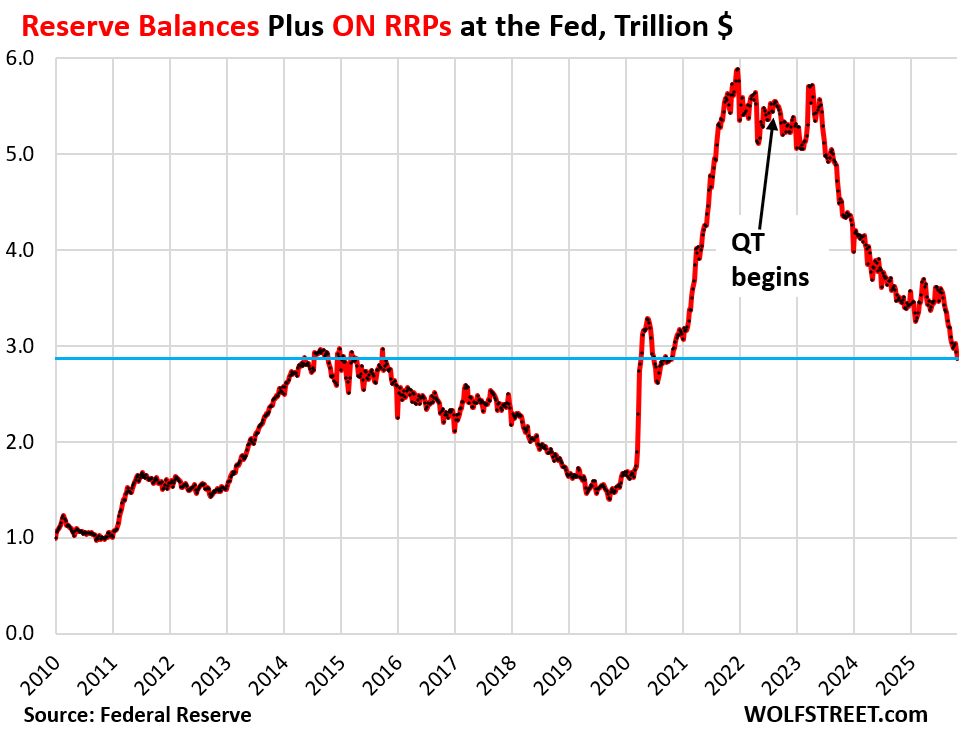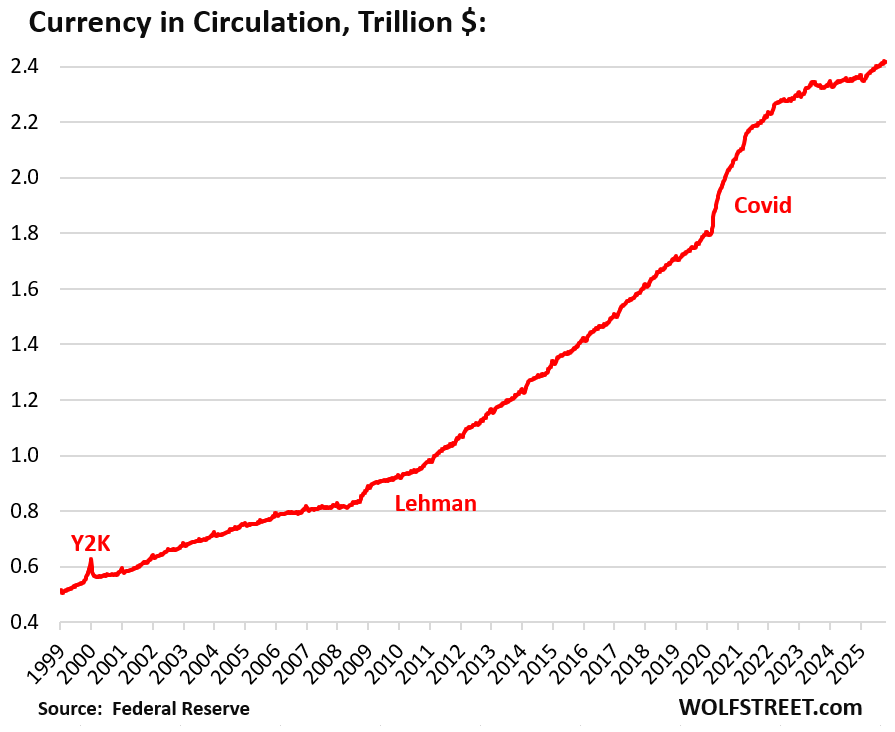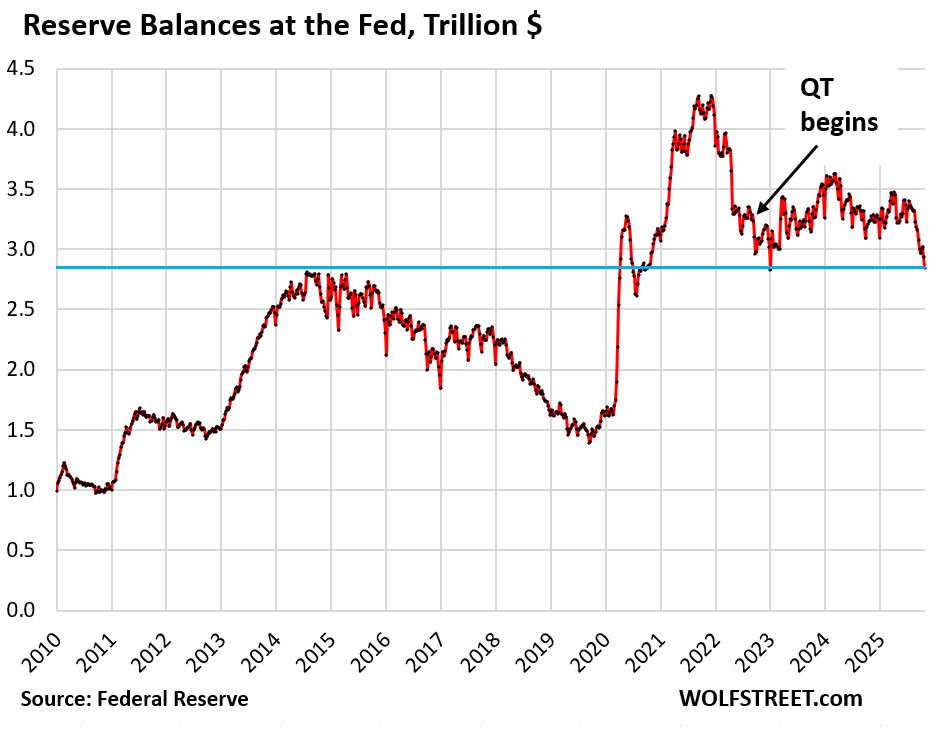Reserves will shrink further when the balance sheet stays flat after QT ends.
By Wolf Richter for WOLF STREET.
The Fed decided to end the reduction of its securities holdings as of December 1, and keep the balance sheet “steady for a time while reserve balances continue to move gradually lower as other non-reserve liabilities such as currency keep growing,” Powell explained at the press conference on Wednesday. This continued decline of reserve balances is a mild form of balance sheet tightening; which is why Powell brought it up. More in a moment.
With its QT, the Fed has been targeting these reserve balances. Reserves are liquidity that banks deposit at the Fed and earn interest on (Interest on Reserves, or IOR, 3.9% since the FOMC meeting). Reserve balances had exploded during the years of massive QE.
What had also exploded during QE was the liquidity that money market funds (mostly) put on deposit at the Fed, via the Fed’s Overnight Reverse Repo facility, or ON RRPs, that the Fed currently pays 3.75% interest on.
Both reserve balances and ON RRPs are liquidity, one from banks, the other from non-banks. They’re both liabilities on the Fed’s balance sheet (money the Fed owes). QE ballooned both of them. And QT drained both of them.
As per today’s balance sheet, compared to the peak:
- Reserves dropped by $1.40 trillion to $2.85 trillion (from $4.25 trillion at the peak in December 2021).
- ON RRPs dropped by $2.35 trillion to near zero (from $2.37 trillion at the peak in September 2022).
But the peaks and drawdowns of reserves and ON RRPs didn’t occur at the same time: In 2022 there was a big shift of liquidity from reserves to ON RRPs, and then in 2023 from ON RRPs back to reserves.
So given the shifts between them, it’s useful to look at them combined as a measure of excess liquidity created by QE and drained by QT.
Reserves and ON RRPs combined peaked in December 2021 at $5.87 trillion as QE was being tapered out of existence.
In October, they dropped by $109 billion, according to the Fed’s balance sheet today. Since the peak, they’ve dropped by $3.0 trillion to $2.87 trillion, the lowest since April 2020, and where they’d first been in late 2014 toward the end of “QE infinity.” This is what the Fed wanted to accomplish with QT:

Reserves shrink further as balance sheet stays flat: Powell
Powell explained in the Q&A: “If you freeze the size of the balance sheet, the non-reserve liabilities, currency, for example, will continue to grow organically; and because the balance sheet is frozen, you have further shrinkage in reserves, and the reserves is what we are managing.”
The biggest non-reserve liability is currency in circulation (paper dollars). The amount of currency in circulation is demand-based. Banks have to be able to provide paper dollars when their customers go to the ATM. The banking system has to have enough to meet this demand, and banks get these “Federal Reserve Notes,” as they’re officially called, from the Fed in exchange for collateral, such as Treasury securities. The Fed makes a profit: It exchanges non-interest-bearing paper dollars for interest-bearing securities and keeps the interest.
Currency in circulation is now at $2.42 trillion, up by 2.7% from a year ago, and up by $600 billion from January 2020. During times of uncertainty (Y2K, Lehman bankruptcy, and Covid), there are bursts of demand for currency. During normal times, currency rises gradually.

This rise of currency in circulation will reduce reserves if the balance sheet and thereby total liabilities are kept steady. This also occurred in 2015, 2016, and 2017, the years during which the balance sheet was also kept steady.
Fluctuations in the other two big liabilities – ON RRPs and the government checking account (Treasury General Account) – also impact reserve balances. The TGA can have a substantial impact on reserve balances during and after the periods of the debt ceiling. In addition, there are sharp drops in reserves at year-end. So reserve balances fluctuate widely, but the trends are still clear:

Enjoy reading WOLF STREET and want to support it? You can donate. I appreciate it immensely. Click on the mug to find out how:
![]()


Wolf,
Do you see the balance sheet / QT as potentially being back in play if inflation picks back up (or fails to fall as forecast)? Or is the Fed afraid to go below this point, and any future inflation fighting will be through Fed rates and “twists” to this balance?
-b
Powell is the architect of this mega-balance sheet and of the “ample reserves regime.” He doesn’t want to back away from it. A new Fed chair, if so inclined, could start persuading the other FOMC members that a shift away from the “ample reserve regime” is the way to go. There has been some loose talk on that. But that will never happen under Powell (and it might not under other chairs).
I think an argument could be made we have barely reached “ample” and could resurrect QT for quite a while before reaching the edges of “scarce”. Even there the standing repo facility seems like it should keep anything from blowing up unexpectedly. I do hope a future fed chair reconsiders drawing down the balance sheet further.
Well Said!!
Thanks Wolf.
As usual, FED chickening out little early. They could easily go for another 6 months. QT was already slowed down a lot. In Presser, Powell said the number is low so doesn’t make sense to wait.
It’s not about amount, it is about sending a message to Markets, QT is ON.
Also why to roll ONLY MBS to T-Bills? Why NOT turn maturing Notes and Bonds into Bills for certain time period? I understand there is no demand for 2-3T Bills as of today, but even monthly roll-off amounts are gradual. If you want to change the composition, start it now. FED cant be proactive to stop QT but lazy and reactive when it comes to change composition.
Also no news on selling the MBS. Last year, there was lot of talk. Nothing recently.
“Also why to roll ONLY MBS to T-Bills? Why NOT turn maturing Notes and Bonds into Bills for certain time period?”
This will come, but as you can see, it’s one step at a time. They will announced that step in a future Fed meeting.
Total reserves: Jan 2018: 2,281. Xmas massacre Jan 2019: 1707. Pre covid Jan 2020: 1715. June 2020: 3,026, Apr 2021: 3,888, Sept 2021: 4,193. JP sucked liquidity. Thereafter JP drained reserves: Sept 2022: 3,133. In Sept 2022 DXY peaked at 115. In Oct 2022 SPX dropped to: 3,491. Tariffs: Mar 2025: 3,408, June 2025: 3,356, Sept 2025: 3,068. The Fed drained reserves. ES reached: 6,950. Prof Spencer: the Fed tightened credit. Interest is the price of credit, not the price of money. Money flow matters more than interest rates. Interest rates: bs. Total reserves : H.6 Money Stock Measures.
The balance sheet is only tangentially related to this, but after reading about Amazon, Google and Microsoft’s results, I find it very concerning that, in an era where the economy grows at 3%, these companies can have their revenues and profits increase by 20-40% every year, year after year. What it means is that they’re taking a larger and larger percentage of the economy, and that will of course lead to their having immense social and political power.
To be clear, I don’t care if they “beat” earnings, as that’s a nonsense Wall Street game. I’m talking about increases in actual revenues and profits.
Looks like there is no inclination to get back to not paying interest on reserves by reducing the level of reserves to the point they are binding and purchase or sale of Treasuries controls overnight interest rates.
Paying interest on reserves at the margin reduces the incentive for banks to lend to the private sector.
I think an argument could be made to reduce the incentive for banks to lend to the private sector. The U.S. is drowning in government debt. If the government wants to inflate away its debt, then lending to the private sector is going to disproportionately help the folks and businesses taking out loans and hurt the banks, who would get squeezed.
The folks and businesses taking out loans don’t always make their payments either, especially during a downtown. That scenario would put additional pressure on banks. Personally, I’d rather live with the structural integrity of the banking system being more intact with slower growth compared to higher risk to banks for *potentially* higher reward.
And more loans after all the PPP loans and excess capital pumped from QE? Let’s not refill the punch bowl, please.
The money stock can never be properly managed by any attempt to control the cost of credit. So, our money and banking system is being grossly mismanaged.